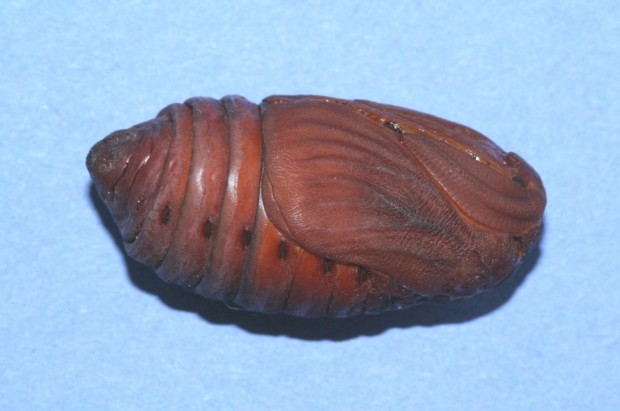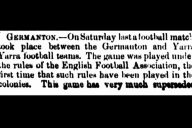When Melbourne City made their debut in October 2014 I took the David Attenborough route and described them as Melbourne Pupa FC.
For those of you who didn’t read the article or need a biological refresher – a pupa is the stage of an insect’s life when it undergoes the transformation from larva to imago. For example, when a caterpillar (larva) turns into a butterfly (imago) the pupal stage is known as a chrysalis.
The club was in the first stage of transformation on and off the pitch, with Melbourne Heart fans trying to work out who or what they are supposed to supporting.
Two seasons later and the picture is not much clearer, apart from the fact that the A-League is a much more interesting place with two teams that represent Melbourne. A logical starting point would go like this: like football, want to support an A-League team, don’t like Melbourne Victory, support Melbourne City, but with shades of sky blue getting in the way of red and white.
In practical terms, what Melbourne City did get under the ownership City Football Group was financial stability other A-League franchises dream about and a pretty schmick training facility A-League players dream about.
On the pitch
The weight of Heart’s underachievement has been worn like a yoke by the club’s fans and I didn’t have to be a football genius to presciently describe Melbourne City’s shortcomings after the first home game of the 2014/15 season.
Even though they have bolstered their midfield, the team can’t be considered serious contenders for the title as the squad is bereft of actual left and right backs. A striker with a proven goal-scoring record also needs to be signed. With Manchester City’s much talked about scouting network and resources, there is no excuse this can’t be achieved. The jury is still out on John van’t Schip but a verdict will be delivered soon enough.
At the end of City’s first season their home and away record read.
| Played | Won | Drawn | Lost | Goals For | Goals Against | Points | |
|---|---|---|---|---|---|---|---|
| All Matches | 27 | 9 | 8 | 10 | 36 | 41 | 35 |
| Home Matches | 13 | 6 | 5 | 2 | 18 | 10 | 23 |
| Away Matches | 14 | 3 | 3 | 8 | 18 | 31 | 12 |
The team finished 5th out of 10 teams, struggled to find the back of the net, beat Wellington Phoenix away in a shock result to record the franchise’s first ever finals win, then was comprehensively outplayed by Melbourne Victory in the semi-final.
Or in the spin of Melbourne City CEO Scott Munn from July 2015 – “We improved significantly on the field last year, up from last to fourth, and lost to the ultimate winners who were the best team all year.”
Despite the misgivings of many fans, JVS remained as manager.
To their credit, Melbourne City went about about trying to fix their shortcomings for season 2015/16 with mixed results. They brought in an injury prone right back (Ivan Franjic), a left back who still hasn’t figured out the caper (Michael Zullo), an old man who proved to be a great addition, goalkeeper (Thomas Sorensen), and a crocked old centre back (Aaron Hughes) for a summer holiday.
But the crowning achievement of their off-season recruiting was the capture of perennial European underachiever and super talented Uruguayan striker, Bruno Fornaroli.
Melbourne City were also proactive during the January transfer window by trying to trade their way to cover for departures, fix up shortcomings and become a better balanced squad.
Goodbye – Erik Paartalu, Stefan Mauk, David Williams and the forgotten marquee who couldn’t even make the first eleven, Robert Koren.
Hello – Osama Malik, Anthony Caceres (via a short lived loophole courtesy of Man City), Nick Fitzgerald and Alex Wilkinson.
The team became the most entertaining team to watch in the A-League with the triumvirate of Aaron Mooy, Harry Novillo (when he was behaving himself) and Fornaroli striking terror into opposition rearguards.
They conceded many, they scored even more. But when it came to the crunch, when it came to the games that mattered, the games that separated the champions from the contenders, and even though City had the best midfielder and striker in this wide brown land, they buckled and fell away.
| Played | Won | Drawn | Lost | Goal For | Goals Against | Points | |
|---|---|---|---|---|---|---|---|
| All Matches | 27 | 13 | 5 | 9 | 63 | 44 | 44 |
| Home Matches | 14 | 9 | 2 | 3 | 35 | 20 | 29 |
| Away Matches | 13 | 4 | 3 | 6 | 28 | 24 | 15 |
Melbourne City finished 4th out of 10 teams, beat the Perth Glory in their first ever home final, then was outplayed by Adelaide United in the semi-final.
Again, despite the misgivings of many fans, JVS will stay as manager for season 2016/17.
Off the pitch
Surrounded by those ubiquitous empty green seats, I sat in AAMI Park and got my money’s worth on my season ticket watching this entertaining, yet fragile, home team score at a rate of 2.5 goals per game. “Where was everyone?” I would think to myself. Sure, the home crowds have grown since Heart days, but City season 1 to City season 2 seemed to remain pretty stagnant.
I took out my trusty calculator to see if the empirical evidence backed up this observation.
Average Melbourne City Home Crowd
(excluding Melbourne Derbies & Finals)
2014/15: 9040
2015/16: 8778
Now, the switched on readers out there would’ve pointed out that the 2014/15 figure is skewed because of the Villa effect, the super marquee’s brief two game visit provided City with two of their three biggest non-derby home crowds in City/Heart history – 15,717 & 13,083. (The other being the day Del Piero visited in Feb 2013 with Sydney FC – 13,752.)
Ok. Back to the trusty calculator.
Average Melbourne City Home Crowd
(excluding Melbourne Derbies & Finals & David Villa)
2014/15: 7969
2015/16: 8778
Year on year this represents a 10% increase, but try as I might to dress this mutton of a figure up as lamb, they are in the cold light of day disappointing numbers.
In July 2015, on the same day that Scott Munn reminded us of the team’s improvement on the pitch, he said the following.
“Our metrics on social media are incredible. We grew 150 to 160 per cent last year. Twitter, Facebook and Instagram are really growing exponentially. Season tickets were up over 11,000 – we grew 70 per cent.
“The goal for us is 14,000. We are very bullish we will get there.
“This year we have to make another step forward.”
When I first read this, I thought Scott must’ve been bingeing on way too many power of positive thinking tapes during the off-season.
Seriously, how was this possible? Especially without a marquee like David Villa. Was he going to get a celebrity hypnotist to get a theatre full of suckers to hand over their credit card details.
Then the season happened, and just in case you needed reminding again, City started banging in the goals, made a serious title run, a midfield maestro brought smiles on the faces of those in his presence and the most captivating striker to grace a pitch in Melbourne in 20 years went on a thrilling scoring run.
And yet, Melbourne City still failed to get traction not only in the attendance stakes, but also in Munn’s membership stakes.
Melbourne City Memberships
2014/15: 11,759
2015/16: 9,548
I don’t find the figures too disappointing. But then again I’m a realist and I wouldn’t go out and make public a figure which was basically a fantasy. However, the fact that Melbourne City only reached two thirds of their stated membership target is a failure.
In trying to identify some of the reasons Melbourne City missed their attendance and membership KPIs I have come up with the following.
The Marquee
Lack of a genuine, turnstile turning, marquee player.
Marketing
The failure to market their star players, especially Fornaroli when it became obvious they had a star in their midst. Where were the billboards up to declaring the new King of Football in Melbourne in the CBD? Where was the buzz?
Another example of lazy and uninspired marketing which really got my goat was the shoddy generic radio advert used last season. All it did was advise the listeners who City were playing that weekend and to bring the family along as samba muzak played in the background (because it’s supposed to mean football even though there wasn’t even a Brazilian in the squad, go figure). I’d be surprsied if it even pulled one person in. There was nothing about how important the upcoming game was and what it means to the team, or to watch Mooy and Fornaroli in action…nothing. How hard is it, to write and produce a simple advert for each game?
Media
The CFG playbook of keeping a low media profile and letting your football do the talking is one of the most interesting developments in the transition from Heart to City. It has resulted in the disappearance of Scott Munn and football operations manager John Didulica. The two of them used to be regular guests on Melbourne radio and they were all too happy to get the Heart message across in what is a very congested Melbourne sporting landscape. Now, we don’t hear from them at all. In the meantime, figures like Melbourne Victory CEO Ian Robson and manager Kevin Muscat are only too happy to go on local radio, field soft questions from not so knowledgeable hosts and promote their team.
What applies to Manchester City, where they don’t have to sell themselves for reasons that are patently obvious, doesn’t apply with Melbourne City. There is a more than half empty stadium that needs filling, there are 12 professional football teams in Melbourne representing four different codes all vying for a piece of consumer action, and CFG’s little investment just happens to have the smallest following out of the lot. Short of providing a Lampard, Villa, Pirlo, like CFG does to its middle sized facsimile, more fans aren’t just going to turn up just because they happen to exist.
Conclusions
Melbourne City remains a pupa. Despite their critics, CFG have stuck by Heart stalwarts Munn, Didulica and JVS. They have opted for a patient evolutionary approach rather than foment an explosive football revolution. In the process, season 2 City became less poop. But will this approach work in season 3? And what will be done to remedy their evident shortcomings on and off the pitch? The reappointment of JVS has not been welcomed by many of the fans, in this respect they see stasis not evolution.
And in case CFG have still not realised from their HQ in Manchester, most Melbourne City fans don’t care much about the playing fortunes of Pappa Bear in Manchester and Mamma Bear in New York, but if CFG are spending some of their petrodollar billions on Baby Bear by improving our domestic football, men’s and women’s (City’s invincible W-League team), then they will be grateful. The poles will melt, great cities will flood, but hey, they got great football in return. We are truly in the age of Post-Modern Football.
I will still be turning up next season. Who knows what it will bring, who will be on the pitch and how many will show up. It’s early days in a long off-season.
Feature photo: Pupa of Male Cecropia Moth courtesy of Megan McCarty
















